Mapping Health Equity: Start With Race
Race and health are tragically linked. Race is not a risk factor for disease; racism is. Racism leads to inequities in health outcomes, including low birth weight, high blood pressure, and poor self-rated health. A legacy of oppression inevitably led to the unequal impact of COVID-19 in Black and Latinx communities. As mySidewalk cited in our recent paper, Mapping Coronavirus' Economic Impact:
Not only has the additional economic and social strain of the pandemic contributed to civil unrest, but the specific ways in which historical inequity has driven economic and health vulnerabilities in communities of color have resulted in a more significant impact. When black Americans are dying from COVID-19 at rates three times the rate of whites and have suffered sharper job losses, it’s no fluke that tensions have boiled over at the same time.
The Public Health leaders we support every day are feeling an unprecedented responsibility for influencing policy to reduce racial tensions. Recent analysis shows that the vast majority of public health staff don’t feel competent in creating or changing policy.
We owe it to the field of public health to equip staff to create equitable policy change. This article covers insider tips on how to develop persuasive policy, based on key takeaways from a highly successful, equity-centered health initiative.
Why CHIPs & CHAs Should Start With Race
Medical care accounts for only 10 to 20% of health outcome contributors. The majority of what drives health outcomes comes from a person’s context – their world, their challenges, and their opportunities. And there is no part of that context that isn’t impacted by a person’s race – it’s unjust and heartbreaking. This phenomenal article Why Public Health Should Lead With Race said it beautifully:
We lead explicitly — though not exclusively — with race because racial inequities persist in every system across the country, without exception. We can’t find one example of a system where there are no racial disparities in outcomes: Health, Education, Criminal Justice, Employment, and so on…
We also lead with race because when you look within other dimensions of identity — income, gender, sexuality, education, ability, age, citizenship, and geography — there are inequities based on race. Knowing this helps us take a more intersectional approach, while always naming the role that race plays in people’s experiences and outcomes.
The Health Equity Guide article also gives a helpful list of organizations that are doing an excellent job of leading with race. If you need some inspiration, start there. We also appreciate the organizations outside of public health, like our customer, The Greater Washington Community Foundation, who are pushing for equity. They’re working to engage their community, particularly seeking out voices that are underrepresented in philanthropy. That engagement becomes the cornerstone for creating an equity-driven response.
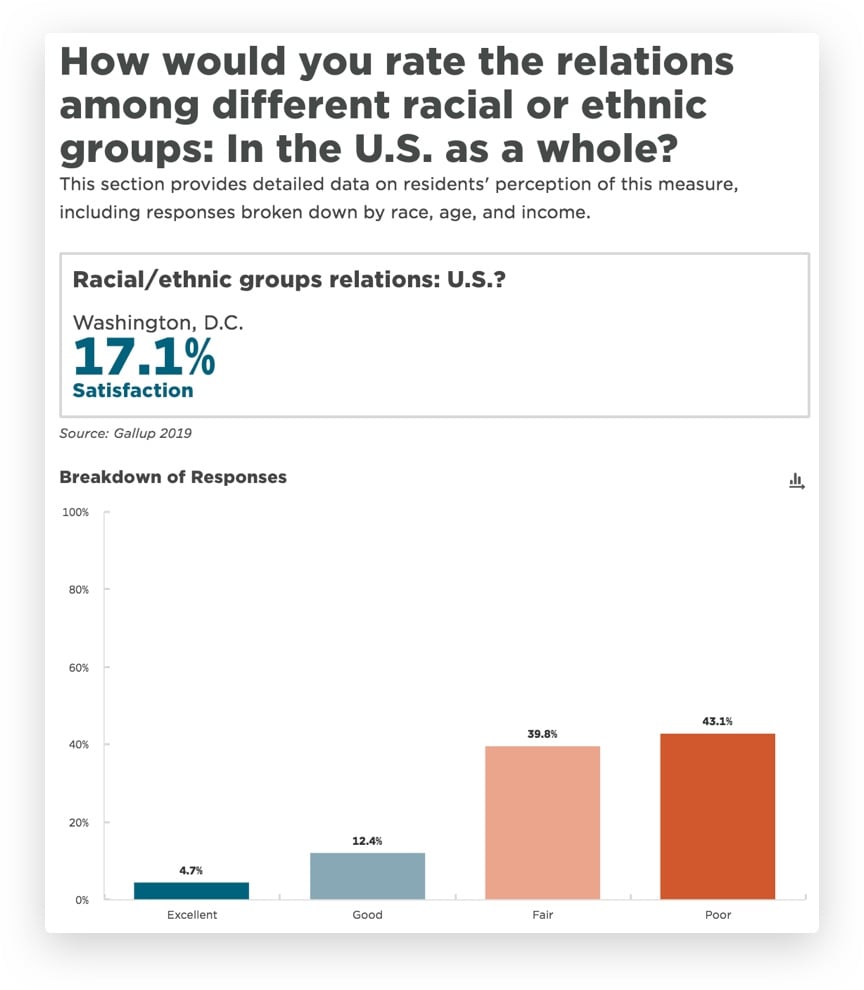
Image courtesy of VoicesDMV
Talking about race is fundamental because the social construct of race impacts everything. Acknowledging structural racism can be painful, but ignoring what COVID has revealed so starkly is a disservice to our communities.
Case Study: The Power of Mapping Racial Equity
The goal of a Public Health leader is to break down the impact of racism on health and present effective solutions to heal the community.
Imagine a Deputy Health Officer working for a large midwestern city. Her name is Jennifer. She’s working on a project to reduce the number of school days local children miss. Her community has significant racial inequities, stemming from racist housing, and economic policies.
There are clear inequities in the life expectancy between White and Black residents, the difference varying dramatically from zip code to zip code. Those who are white, live an average of 6.5 years longer.
One of the main drivers of this inequity is unequal access to high-quality education. So, city leaders work to improve educational outcomes, starting with reducing the number of days elementary school is missed in six high priority zip codes. The theory is that improving attendance in the early years will increase graduation rates. Graduation rates are a powerful predictor of lifelong health. By intervening early, city officials hoped that investments at a young age would pay off through longer lives.
The data showed that the kids who missed the most days of school were predominantly from Black, low-income neighborhoods with high rental housing.
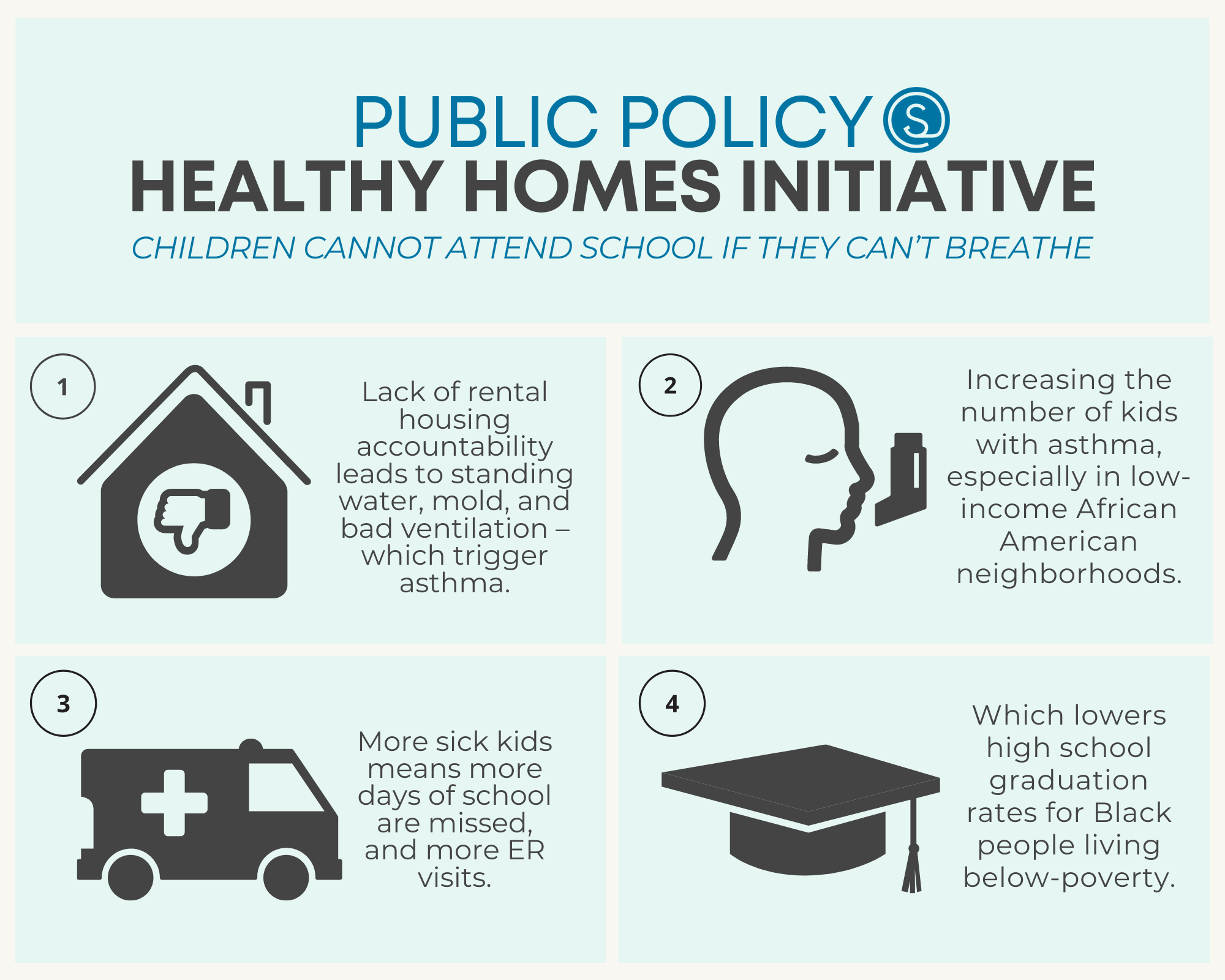
When homeownership is stolen from communities of color historically, we see a higher number of renters in Black and Brown neighborhoods in later generations. If rental housing is unsafe, the health hazards can cause lead poisoning, injuries, and asthma. In this particular city, no agency had the authority to hold rental units to standards of safety. There was no one to call for help when a renter was exposed to standing water, mold, and or poor ventilation. Kids were missing school because of asthma attacks, and there was no one to ensure that their family was protected.
So Jennifer’s team created a Healthy Homes ballot initiative, which would allow the health department to inspect rental homes for dangerous conditions, including asthma-inducing risks. Similar cities had such authority, and they were confident it would be useful for theirs. But there was one key obstacle.
In this state, public agencies couldn’t legally advocate for their initiatives. Any program that was going to charge fees in a local municipality had to go to a ballot measure. If the taxpayers were going to pay for it – they had to approve it.
So what was this health department to do? They couldn’t legally appeal directly to the public for support, but they needed to combat strong opposition. Some community advocates argued the plan would backfire and limit the number of affordable rental housing units. So, Jennifer’s team looked to consultants to help them prove their case.
This is not a hypothetical story. It’s the true story of the KCMO Health Department, led by Dr. Rex Archer and Naser Jouhari, along with a team spanning every division in the Department.
Image courtesy of KCMO.GOV
The KCMO Health Department leveraged mySidewalk, along with a partnership with the Win-Win project, to share data-driven estimates of how the initiative would improve the community. The estimated impact was then integrated into the KCMO virtual CHIP dashboard.
They estimated that by improving indoor air quality, the program would:
- Give target zip codes with the lowest life expectancy, an additional 15,000 school days, and 55,000 fewer days of school would be missed annually
- Serve 6,767 below-poverty level children with asthma, resulting in 1,400 fewer annual ER visits
- The initiative would have a $1.67 ROI with a 3-year breakeven
The Healthy Homes initiative was a big success, so much so it’s been expanded to include Section 8 and nonprofit housing. Hundreds of homes have been remediated because of indoor air quality risks. Despite previous skepticism, 93% of landlords have registered with the city. The initiative bolstered the broader affordable housing conversation, providing a spotlight, and bringing much-needed momentum and attention from the public.
For details on this project, including specifics on strategy and method, check out the upcoming September report of the Journal of Public Health Management Practices. If you have a subscription, you can get the article ahead of print here.
We applaud the KCMO Health Department for the way they continue to boldly recognize the city’s historical racism and current inequities. As they put it so well, “In Kansas City, skin color and ZIP code matter.”
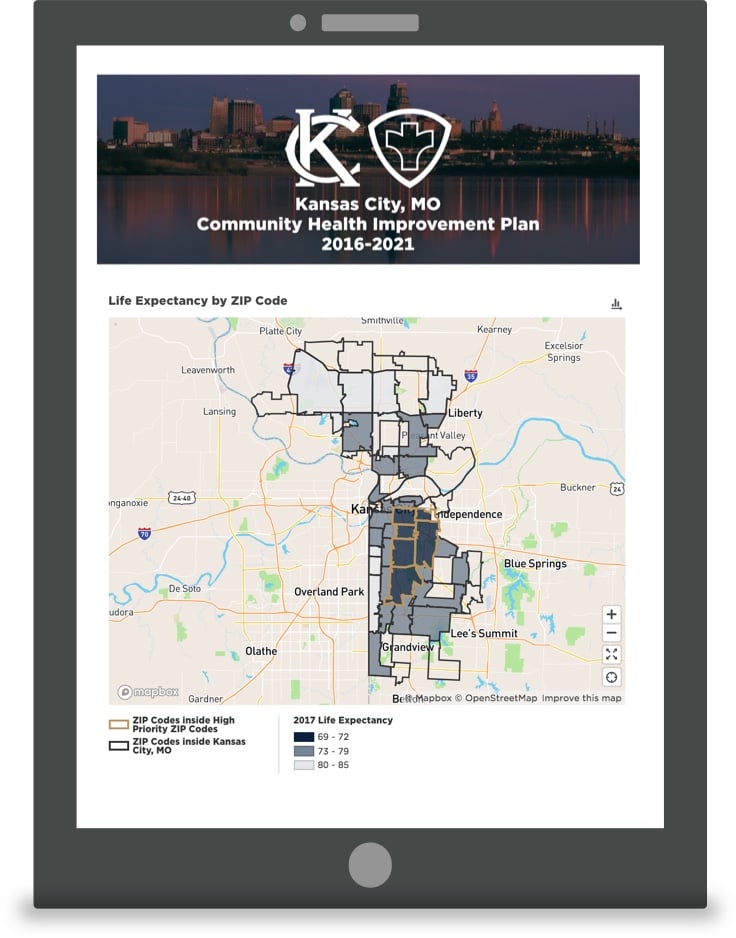
Map courtesy of KCMO CHIP Dashboard
Their Community Health Improvement Plan is all the stronger for their courage. We also admire how they recently relaunched their Community Health Assessment with a lens of identifying the root causes of inequities.
What Made This Policy So Effective?
The Healthy Homes initiative was controversial. Skeptics gloomily predicted that it would fail, since implementation would cost both taxpayers and landlords. Nevertheless, it passed with 57% of the vote.
Why? This initiative included some crucial elements that set it up to succeed.
How to Create Persuasive Policy
Establish a clear goal: Healthy Homes was effective because there was a focused, measurable, and achievable goal. Especially compelling were the specific estimates of what the positive impact of the program would be.
Get Creative & Find partners: roadblocks are inevitable. Since the Department couldn’t advocate for the initiative directly, they got creative and sought outside help. The next time you hit a snag, consider enlisting the help of a vendor or nonprofit partner.
Make the data human: the Healthy Homes goal was backed with credible, humanized data that was supported by policy professionals. Likewise, rather than being based on national averages, the baseline was localized to their city, making it even more relevant. Unlike most dry data, this intelligence was extremely personal and motivating. Measuring in lives is always more motivating than just measuring in numbers.
Tell a powerful story: this program was unique because people understood why it mattered and how it would make things better. The initiative utilized simple, poignant messages like “Children cannot attend school if they can’t breathe," which resonated strongly with the community.
Use data visualizations: another reason this program passed was that it brought data to life with visuals and maps. Breaking down the disparity by target zip codes mapped the inequity. Doing this turned something abstract like historical racism into something concrete and real. It allowed people to see who would suffer if something didn't change.
As you read this case study, you might be so overwhelmed you can't even think about updating your CHIP, much less advocate for new policy. We know that right now, it is beyond challenging to be a public health worker and that the COVID-19 backlash you may be facing is scary.
Thank you for showing up every day for a job that sometimes feels impossible. What you are doing matters. We hope this story leaves you inspired.
We hope you're encouraged that change is possible, creating policy is achievable, and the wounds of racism can be healed.
Share this
You May Also Like
These Related Stories
A Quick Guide to the (New) 10 Essential Public Health Services

2 SDoH Reports Every Public Health Director Needs
-3.png)

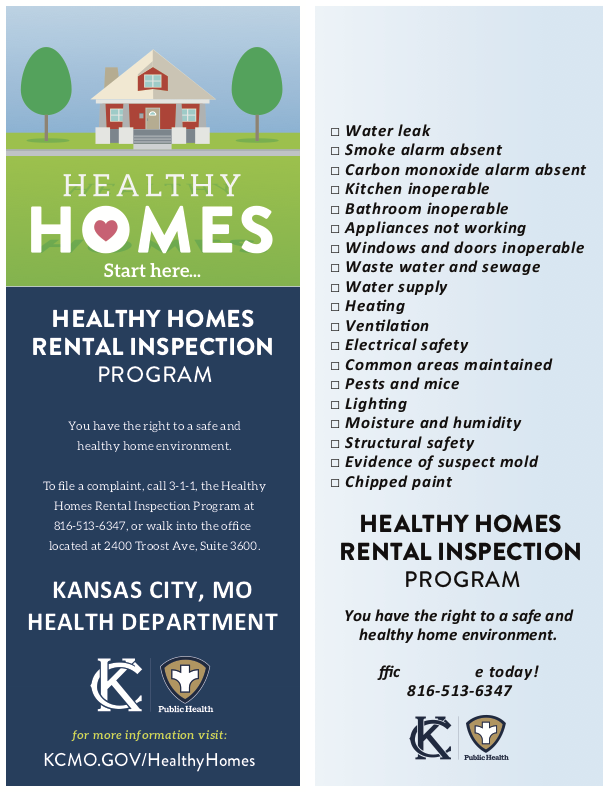
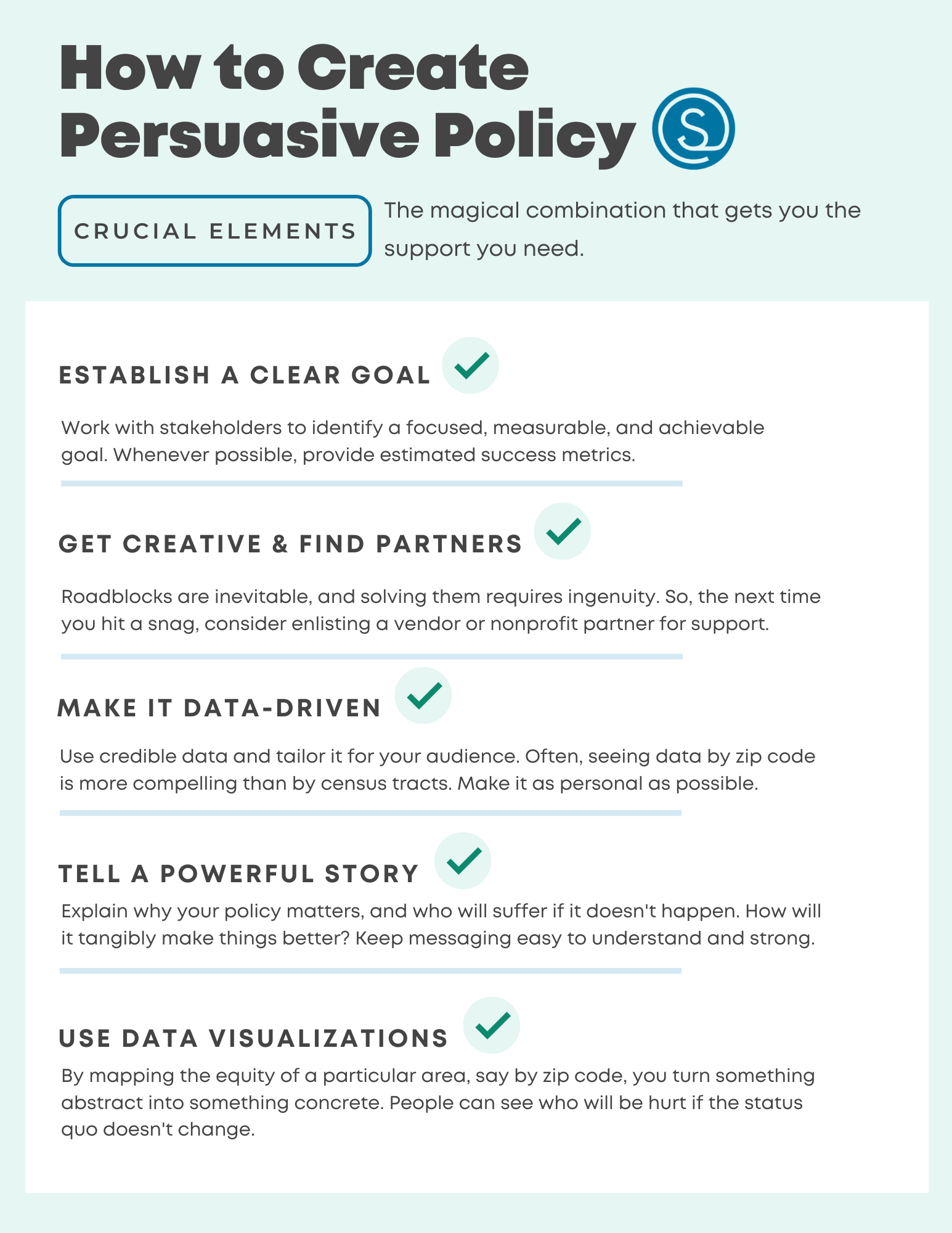
Comments (2)